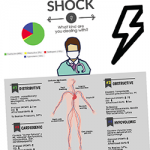Even within the confines of 140 characters, much can be said. However, one of Twitter’s great features is that it allows pictures in exchange for characters. When it comes to medical education, tweets with images seem to have special potential to go viral. EM educators like Salim Rezaie, MD, FACEP (@srrezaie), a physician in the division of emergency medicine and hospitalist medicine at the University of Texas Health Science Center at San Antonio, and Michelle Lin, MD (@M_Lin), associate professor of emergency medicine at the University of California, San Francisco, have turned the creation of succinct medical-education images into a form of high art, earning countless views and retweets. Last month, a new account called @EMinfographics popped up and caught my eye. This account is getting in on the act and has already posted a handful of excellent images that anyone can save to their smartphone photo album or desktop with a couple of touches or clicks. I frequently save these images in a “medical images” album on my phone for quick reference during shifts or when teaching. For this month’s column, I’m highlighting some great images that showed up on my feed and that prove a great medical-education picture can be worth 1,000 characters.
Explore This Issue
ACEP Now: Vol 34 – No 05 – May 2015@EMinfographics posted this image on shock (see Figure 1). On one slide, they’ve packed in important distinguishing features of the four major types of shock we have to rapidly diagnose and treat. It’s a great image for teaching, and it’s even a good reminder to the seasoned vet.
Speaking of shock, Hilary Fairbrother, MD, MPH, FACEP (@hilaryfair), assistant director of undergraduate medical education at the Ronald O. Perelman Department of Emergency Medicine at New York University School of Medicine in New York, tweeted these two images (see Figure 2) from
a lecture by Peter Viccellio, MD, FACEP, clinical professor and vice chair of emergency medicine at Stony Brook School of Medicine (who makes a cameo in the images), with the simple title “Epi drips for dummies.” The first image is the recipe for making a 1 mcg/mL epinephrine drip, and the second gives two titration schemes. I’ve already used these images during my shifts.
Davis Gattas, MD (@dgattas), an intensivist at the University of Sydney, tweeted this image (see Figure 3) from a hot-off-the-press New England Journal of Medicine article that suggests systemic inflammatory response syndrome (SIRS) may not be as accurate or useful as we previously thought.1 The tweeted
Pages: 1 2 | Single Page







No Responses to “Medical Education Images on Twitter Have Potential to Go Viral”